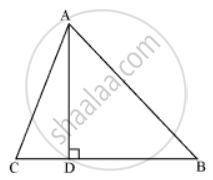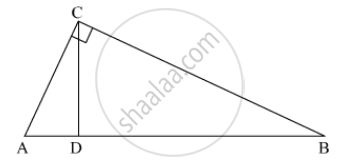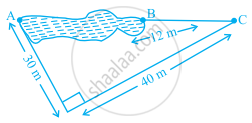Advertisements
Advertisements
Question
The perpendicular AD on the base BC of a ∆ABC intersects BC at D so that DB = 3 CD. Prove that `2"AB"^2 = 2"AC"^2 + "BC"^2`
Solution 1
We have

DB = 3CD
BC = BD + DC
The perpendicular AD on the base BC of a ∆ABC intersects BC at D so that DB = 3 CD. Prove that 2AC2 + BC2.
We have,
DB = 3CD
∴ BC = BD + DC
⇒ BC = 3 CD + CD
`⇒ BD = 4 CD ⇒ CD = \frac { 1 }{ 4 } BC`
`∴ CD = \frac { 1 }{ 4 } BC and BD = 3CD = \frac { 1 }{ 4 } BC ….(i)`
Since ∆ABD is a right triangle right-angled at D.
`∴ AB^2 = AD^2 + BD^2 ….(ii)`
Similarly, ∆ACD is a right triangle right angled at D.
`∴ AC^2 = AD^2 + CD^2 ….(iii)`
Subtracting equation (iii) from equation (ii) we get
`AB^2 – AC^2 = BD^2 – CD^2`
`⇒ AB^2 – AC^2 = ( \frac{3}{4}BC)^{2}-( \frac{1}{4}BC)^{2}[`
`⇒ AB^2 – AC^2 = \frac { 9 }{ 16 } BC^2 – \frac { 1 }{ 16 } BC^2`
`⇒ AB^2 – AC^2 = \frac { 1 }{ 2 } BC^2`
`⇒ 2(AB^2 – AC^2 ) = BC^2`
`⇒ 2AB^2 = 2AC^2 + BC^2`
Solution 2

In ΔACD
AC2 = AD2 + DC2
AD2 = AC2 - DC2 ...(1)
In ΔABD
AB2 = AD2 + DB2
AD2 = AB2 - DB2 ...(2)
From equation (1) and (2)
Therefore AC2 - DC2 = AB2 - DB2
since given that 3DC = DB
DC = `"BC"/(4) and "DB" = (3"BC")/(4)`
`"AC"^2 - ("BC"/4)^2 = "AB"^2 - ((3"BC")/4)^2`
`"AC"^2 - "Bc"^2/(16) = "AB"^2 - (9"BC"^2)/(16)`
16AC2 - BC2 = 16AB2 - 9BC2
⇒ 16AB2 - 16AC2 = 8BC2
⇒ 2AB2 = 2AC2 + BC2.
APPEARS IN
RELATED QUESTIONS
In the given figure, ABC is a triangle in which ∠ABC < 90° and AD ⊥ BC. Prove that AC2 = AB2 + BC2 − 2BC.BD.

Which of the following can be the sides of a right triangle?
1.5 cm, 2 cm, 2.5 cm
In the case of right-angled triangles, identify the right angles.
Identify, with reason, if the following is a Pythagorean triplet.
(4, 9, 12)
In ∆ABC, ∠BAC = 90°, seg BL and seg CM are medians of ∆ABC. Then prove that:
4(BL2 + CM2) = 5 BC2

In right angle ΔABC, if ∠B = 90°, AB = 6, BC = 8, then find AC.
In equilateral Δ ABC, AD ⊥ BC and BC = x cm. Find, in terms of x, the length of AD.
If the angles of a triangle are 30°, 60°, and 90°, then shown that the side opposite to 30° is half of the hypotenuse, and the side opposite to 60° is `sqrt(3)/2` times of the hypotenuse.
Find the side of the square whose diagonal is `16sqrt(2)` cm.
In Fig. 3, ∠ACB = 90° and CD ⊥ AB, prove that CD2 = BD x AD.

The sides of a certain triangle is given below. Find, which of them is right-triangle
16 cm, 20 cm, and 12 cm
The length of the diagonals of rhombus are 24cm and 10cm. Find each side of the rhombus.
Each side of rhombus is 10cm. If one of its diagonals is 16cm, find the length of the other diagonals.
In a triangle ABC, AC > AB, D is the midpoint BC, and AE ⊥ BC. Prove that: AC2 - AB2 = 2BC x ED
In a right-angled triangle PQR, right-angled at Q, S and T are points on PQ and QR respectively such as PT = SR = 13 cm, QT = 5 cm and PS = TR. Find the length of PQ and PS.
PQR is an isosceles triangle with PQ = PR = 10 cm and QR = 12 cm. Find the length of the perpendicular from P to QR.
∆ABC is right-angled at C. If AC = 5 cm and BC = 12 cm. find the length of AB.
If S is a point on side PQ of a ΔPQR such that PS = QS = RS, then ______.
In a quadrilateral ABCD, ∠A + ∠D = 90°. Prove that AC2 + BD2 = AD2 + BC2
[Hint: Produce AB and DC to meet at E.]
Points A and B are on the opposite edges of a pond as shown in figure. To find the distance between the two points, the surveyor makes a right-angled triangle as shown. Find the distance AB.

The foot of a ladder is 6 m away from its wall and its top reaches a window 8 m above the ground. Find the length of the ladder.
